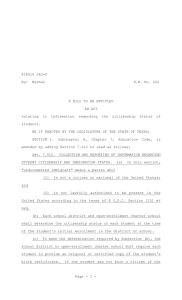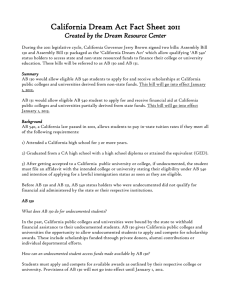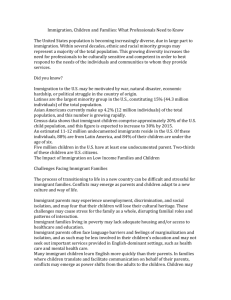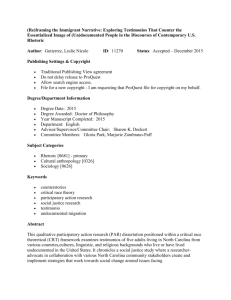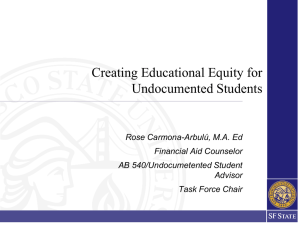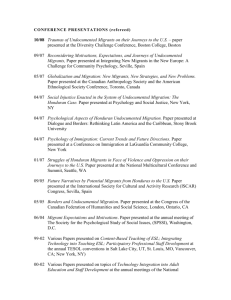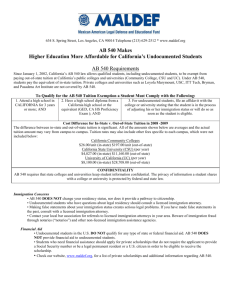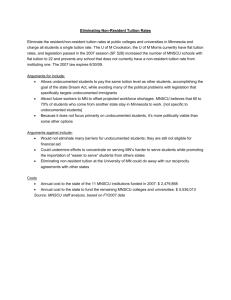Investing in the American DREAM
advertisement
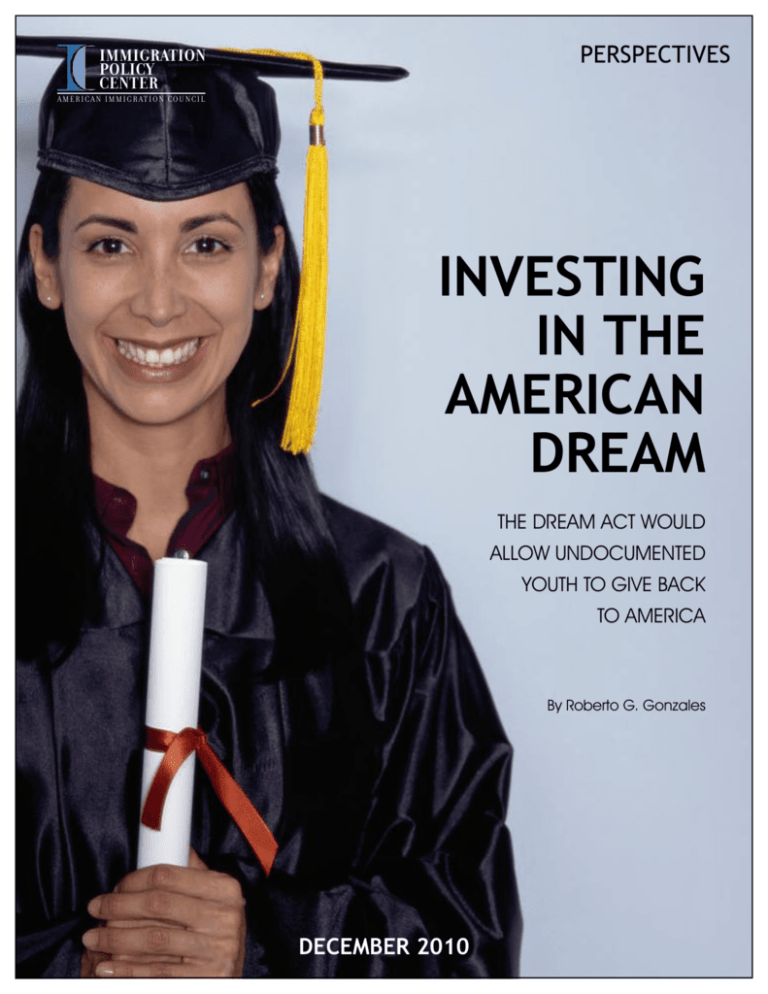
PERSPECTIVES IMMIGRATION POLICY CENTER A M E R I C A N I M M I G R AT I O N CO U N C I L INVESTING IN THE AMERICAN DREAM THE DREAM ACT WOULD ALLOW UNDOCUMENTED YOUTH TO GIVE BACK TO AMERICA By Roberto G. Gonzales DECEMBER 2010 INVESTING IN THE AMERICAN DREAM THE DREAM ACT WOULD ALLOW UNDOCUMENTED YOUTH TO GIVE BACK TO AMERICA BY ROBERTO G. GONZALES DECEMBER 2010 ABOUT PERSPECTIVES ON IMMIGRATION The Immigration Policy Center’s Perspectives are thoughtful narratives written by leading academics and researchers who bring a wide range of multi‐disciplinary knowledge to the issue of immigration policy. ABOUT THE AUTHORS Roberto G. Gonzales is an Assistant Professor at the University Of Washington School Of Social Work. He earned his Ph.D. in the department of sociology at the University of California. His research focuses on the ways in which legal and educational institutions shape the everyday experiences and the transitions to adulthood of poor, minority, and immigrant youth. Current projects include a four and a half year study of undocumented immigrant young adults in Los Angeles, a companion study in Seattle, and comparative projects on immigrant youth in the U.S. and Europe. Gonzales is the author of When Do Papers Matter? An Institutional Analysis of Undocumented Life in the United States (forthcoming), Young Lives on Hold: The College Dreams of Undocumented Students and Why Integration Matters: Undocumented Immigrant Youth and Making a Case for Moving Beyond Enforcement and his work appears in numerous publications. ABOUT THE IMMIGRATION POLICY CENTER The Immigration Policy Center, established in 2003, is the policy arm of the American Immigration Council. IPC's mission is to shape a rational conversation on immigration and immigrant integration. Through its research and analysis, IPC provides policymakers, the media, and the general public with accurate information about the role of immigrants and immigration policy on U.S. society. IPC reports and materials are widely disseminated and relied upon by press and policymakers. IPC staff regularly serves as experts to leaders on Capitol Hill, opinion‐makers, and the media. IPC is a non‐partisan organization that neither supports nor opposes any political party or candidate for office. Visit our website at www.immigrationpolicy.org and our blog at www.immigrationimpact.com. Introduction Each year, tens of thousands of undocumented immigrant students graduate from American high schools and embark on uncertain futures. Their inability to legally work and receive financial aid stalls, detours, and derails their educational and economic trajectories. Most importantly, at any time, they can be deported to countries they barely know. The Development, Relief, and Education for Alien Minors (DREAM) Act is a federal bill aimed at providing immigration relief to these young people. The passage of this bill would grant many undocumented youth access to legal residency and federal financial aid—thus removing legal and economic barriers to higher education and increasing their contributions to America and the likelihood of upward mobility. Why Does America Need the DREAM Act? All American youth, particularly those living in poverty, experience significant challenges when they try to further their education and realize their dreams. Paying for college tuition, supporting one’s family, and getting to school and work on public transportation all present difficulties. Additionally, having the parental support, mentoring, school support, and other early interventions necessary to successfully navigate higher education is important for future success. However, undocumented immigrant youth—those who migrate at early ages and reside in the United States without legal permission—confront an even more troubling mix of circumstances which make succeeding in higher education even more difficult. Their tenuous situation is the result of a confluence of confusing and contradictory laws that allow them to legally attend school, but deny them the opportunities to work, vote, receive financial aid, and drive in most states. At any time, they can be deported to countries they barely know. These young men and women, growing up amid harsh contexts and an elevated climate of fear, represent a sizeable and vulnerable population in need of policy solutions. As growing numbers of undocumented students have matriculated to colleges and universities across the United States, their plight has gained increasing attention. Over the last few years, support for the DREAM Act has grown, and there have been significant efforts pressuring Congress to pass it into law. The public has been presented with stories of high achievers— leaders on their campuses and in their communities—whose talents are wasted because current laws do not allow them to pursue their dream careers. These stories of exceptional hard work and exemplary civic engagement resonate with American values and remind us of success stories told about previous waves of immigrants. Passing the DREAM Act is an important first step towards fixing our broken immigration system. It creates a way for bright and talented young people who grew up in America to legalize their status and achieve their dreams. It is a bipartisan measure that has been around for a decade. 1 What is Holding Back Undocumented Youth? Attending and paying for college can be difficult for many American families, but undocumented students face additional obstacles. Among undocumented immigrant students, the combination of scarce family resources and the exclusion from federal and state financial aid severely limit post‐secondary goals. By law, undocumented students are barred from federal and (with the exception of New Mexico and Texas) state financial aid. Despite the existence of federal laws that outline their eligibility to attend a public K‐12 school, our laws offer no legal guidelines regarding post‐secondary options. At one extreme, Alabama, Georgia, North Carolina, and South Carolina have attempted to ban undocumented young adults from access to their public two‐ and four‐year institutions. However, to date, 11 states—California, Illinois, Kansas, Nebraska, New Mexico, New York, Oklahoma, Texas, Utah, Washington, and Wisconsin—have passed laws allowing undocumented students who qualify under certain provisions to attend public universities at in‐ state rates. But, with the exception of these states, most public universities classify undocumented youth as international students and charge them three to seven times more in tuition. Without financial aid, it is extremely difficult for most Americans to afford a college education. Given the limited economic resources of most undocumented youth, rising tuition rates and high overall cost of post‐secondary education are daunting, if not prohibitive. As a result, only a small fraction of undocumented high school graduates moves on to institutions of higher learning. Beyond the restricted access to financial aid, undocumented students cannot participate in a host of federally funded programs designed to assist low‐income students. Practically, this means that several outreach programs that provide services critical to low‐income and first‐ generation university students—such as academic support assistance, skills‐building, and research opportunities—are off the table for undocumented students. Additionally, immigration laws prohibit undocumented students from activities such as study abroad programs, which entail travel outside the country, and any paid internships or student employment. Today’s undocumented youth and young adults are coming of age amid a hostile political backlash and rising anti‐immigrant sentiment. Over the last decade, as hate crimes aimed largely at Latino immigrants have gained increasing visibility, federal immigration raids of workplaces and private homes have intensified, resulting in the deportation of hundreds of thousands of immigrants. In this last fiscal year, ending September 30th, the U.S. deported 392,000 immigrants. Swept up in this immigration “dragnet” have been many high school graduates and college and university students who have been detained, put into deportation proceedings and, in some cases, deported. 2 When Doors No Longer Open, Dreams Die At some point during their adult lives, doors stop opening altogether for undocumented youth. Whether it is a series of blocked opportunities within the labor market or the end of educational opportunities, there comes a time when these young men and women run out of options. These moments contradict everything these young people have been taught in school and send the message that their dreams will not be realized and that all of their hard work was in vain. In most respects, these young people are already important members of U.S. society. After completing an education in our schools, they envision their futures here, and powerfully internalize American values and expectations of merit. However, there are currently no available structural paths out of poverty for these young men and women. Paradoxically, their efforts to adapt and contribute economically are met with legal obstacles. Rather than valuing them as important societal resources, current policies restrict their options and curb the transformative potential they have in their communities. Without full legal rights, they are barred from the very mechanisms that have ensured high levels of economic and social mobility to other immigrants throughout U.S. history. Such denial is enough to set them on a path of disenfranchisement, poverty, and frustration. This also means there is significant lost potential for the U.S. Without the incentive and means to continue their education, undocumented youth are not continuing their education, and the U.S. is losing out on their productivity, entrepreneurship, and creativity, as well as tax revenue from their potentially higher earnings. Opening Up a Path Allows DREAMers to Give Back to America Undocumented immigrant youth and young adults in the United States are victims of an outdated immigration system. They have the right to a primary and secondary education and, with some notable exceptions mentioned earlier, are generally allowed to go on to college. But their future prospects are severely restricted due to their undocumented status. From a public policy perspective, it makes sense to intervene when a sizable subset of our population is vulnerable and disenfranchised. The economic costs of continuing failed policies only reinforce the necessity of such action. Findings generated from my six years of in‐depth research on the circumstances confronting undocumented immigrant youth and young adults underscore the need to regularize the status of this population of more than 2.1 million nationally. Undoubtedly, legalization lifts the biggest barrier these young people confront, as it allows them to legally participate in a world in which they have already been socialized. They grow up in the United States and have few recollections of any other country. They are as Marcelo Suarez‐Orozco so aptly suggests “de facto but alas not de jure . . . full members of the American family.” 3 Providing viable pathways to legalization can help to lift these young people out of poverty, integrate them into adult society, and give them opportunities to compete for financial aid and jobs. This is not to say that their legal peers are easily and automatically proceeding to upward mobility through traditional means. The alarmingly low educational attainment levels of many Latin American and Southeast Asian origin students are manifested in their low high‐school completion rates. However, for the 2.1 million undocumented youth and young adults, legalization could further bolster their efforts and motivate them to continue to achieve academically. When provided opportunities to improve their circumstances, undocumented immigrants have responded positively. For example, undocumented immigrants who received legal status under the 1986 Immigration Reform and Control Act (IRCA) have moved on to significantly better jobs over time and increased their wages by roughly 15% within five years. In states that provide in‐ state tuition at public colleges and universities, beneficiaries have done as well as their legal counterparts and better than undocumented students in states without such provisions. Given the opportunity to receive additional education and training and move into better paying jobs, legalized immigrants pay more in taxes and have more money to spend and invest. It is, therefore, likely that if currently undocumented youth were granted legal status, they would not only improve their own circumstances, but make greater contributions to the U.S. economy. By passing the DREAM Act, Congress would give undocumented youth a path toward realizing their full potential and an opportunity to give back to the country that has given them the opportunity to succeed. Young people who qualify for the DREAM Act are Americans in every way but their citizenship. They came here in the arms of their parents, and have little knowledge of the country they left behind. They excelled in American schools and J‐ROTC programs, and they simply want a chance to succeed in the only country they know as home. America is the land of opportunity, where every individual has a chance to succeed or fail on his or her own merits. The DREAM Act was crafted in that spirit. Congress should do the right thing, and make those DREAMs a reality. Endnotes 4
